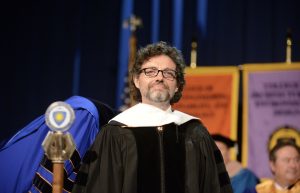Final ‘Star Wars’ film succeeds on most accounts
May 6, 2005
Star Wars: Episode III – Revenge of the Sith
Starring: Hayden Christensen, Ewan McGregor, Ian McDiarmid, Natalie Portman, Samuel L. Jackson
Directed by: George Lucas
Distributed by: Twentieth Century Fox and Lucasfilm Ltd.
Rated: PG-13 for sci-fi violence and some intense images
Stater rating (out of four): ***
Jon Dieringer
Daily Kent Stater
Now this is frustrating.
Episode III: Revenge of the Sith closes the gap between Star Wars films old and new, which develops the dilemma of figuring out who knows what, and which approach should be taken to the series: Start with Episode I and work through them all, or go in with the knowledge of episodes four through six?
It’s a valid point to consider because there are character developments — and this film, in which Anakin Skywalker completes his transition to the dark side, is about nothing if not that — that will completely shock unfamiliar audiences while coming across as obligations to the series’ overall narrative for more hardcore fans (and in some cases, vice-versa). Different audiences will no doubt get different thrills.
But adding more to the frustration is the film itself, which is at once the dark, brooding epic that Star Wars fans have been anticipating for so long as well as a pile of more-or-less amateur garbage.
Chief among the offenses is the acting, which led to unintentional laughter at moments even from those who cheered their way through the rest of the movie.
As Skywalker, Hayden Christensen still has yet to develop beyond his stiff upper-lip, which he uses to express every emotion ranging from anger to sadness. But worse is Natalie Portman as Padmé Amidala, whose delivery alternates between realism and melodrama, neither of which are suited to Lucas’ bureaucratic-cum-Shakespearean dialog.
It’s the crippling blow to what would have been the series’ greatest film because so much of the plot revolves around interaction between the two. To wit: Amidala’s secret marriage to Skywalker has given way to what will eventually become Luke and Leia. Following a vision that she will die giving birth, one much like he had before his mother’s death, Skywalker becomes obsessed with preventing her death, and it complicates things when someone tells him that with the dark side comes the possibility of granting others eternal life.
This is intertwined with — and always seems to pop up in the middle of a great chase scene — the other side of the plot, which is the war between the Republic and the Seperatists.
That Skywalker saves the empire in giving into its corruption and becoming Darth Vader is no secret, and to see him finally don the suit should be the reason to see the film. Unfortunately, even behind the Darth Vader suit — which, unfortunately, is revealed rather matter-of-factly save for a slow, clichéd “suit slowly rises up” shot — Christensen can’t hide how poorly suited to the role he is. He communicates little presence, and it makes all four or so lines of Vader dialog that James Earl Jones has, especially “NOOOO!,” come out flaccid.
But when everyone keeps his or her mouth shut, the movie is a scream a second. Opening with one of the series’ grandest space battles, the movie is jam-packed with thrills so well constructed they are palpable. For those who were thrilled by Darth Maul’s double lightsaber fighting, the Episode III-specific villain, Seperatist General Grievous, has a scene that blows it away — and Yoda’s climactic battle from Episode II is nothing compared to the stuff he does here.
This is the penultimate sci-fi samurai movie that the other installments only hinted at, and not just in terms of the action. At the center of the film is the struggle for power, both the ambiguity of the decisions of those who vie for it and the consequences they face. In this way it’s highly reminiscent of Throne of Blood, Kurosawa’s interpretation of Macbeth set in feudal Japan.
And for the first time in a Star Wars movie, the characters acknowledge the similarities between the Jedi and the Sith, similarities that become more apparent as Skywalker moves toward the dark side.
“Have you ever wondered whether we’re fighting for the right side?” Padmé asks him, and he says that of course the Republic is right. But up until that point, the interests of the Republic and the Jedi always seemed to be one and the same — and of course that isn’t true for long.
The film raises several questions: How do we define good and evil? Is acquiring power inherently selfish? If so, how can the Jedis seek to acquire power for unselfish reasons? Though it’s all in the subtext, the film invites heavy philosophical investigation — and for being in the subtext, it succeeds where the Matrix sequels failed.
And with this being the most politically-charged Star Wars movie, it has something Episode I’s Jar-Jar Binks bullshit and Episode II’s overly complex plot lacked: relevance.
There’s one moment in the movie that encapsulates this best. It’s quick and subtly delivered, but impossible to miss for anyone who’s watched the news in the last four years.
It is the catalyst for the inevitable and highly volatile battle between Skywalker and Obi-Wan:
“You are either with me, or you are my enemy,” Skywalker tells Obi-Wan, who responds, “Absolution is the way of the Sith,” then whips out his lightsaber to defend a hateful, relentless blow from “The Man Who Saved the Republic.”
Rings kinda true, doesn’t it? A fitting note to end on for a flawed masterpiece.
Contact Pop Arts reporter Jon Dieringer at [email protected].
























